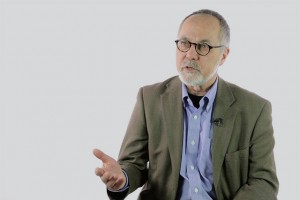Sex in the Middle Ages
Historian Ruth Mazo Karras on church court records, means of contraception, and sex and gender roles in the Mi...
How can a statistical study make citizens’ life better? How can university students contribute to the comfort of the place they live in? What does data analysis have to do with policy decisions? Harvard Professor of Sociology, Christopher Winship, explains why the number of bicycle accidents in Boston has decreased.
Both in academic and in policy circles we are now seeing a sea-change in the understanding of where important policy work is got to be done in the next decade or two. Historically, most academics, most politicians in the United States have always focused on the federal level and felt that where you need it to make social changes in terms of national law. What we see now is huge surge of interest in cities, what can be done in the cities.
And there are really two factors behind this. One is that there is a recognition that in the United States, but really across the world, it’s cities that are the important geographical locations, in which economic activity gets organized, and that there are vast differences now between cities that are very successful and cities that aren’t.
Now, second, of course, is that in the United States approximately 90 percent of the people live in metropolitan areas. So, if we’re talking about where do people live – in a broad sense they live in cities. If you want to make important policies, it’s got to be urban policy.
And then third is that at this point in the United States, because of the conflict between republicans and democrats, it’s basically impossible to get federal legislation passed. We are really in a period now when national politics are more polarized than they’ve been in decades, and it means, essentially, it’s almost impossible to have any effective policy.
The good news is that most cities in the United States are not particularly divided by Republicans vs Democrats. The people who get elected as mayors, and city councils, and stuff usually are getting elected because they’re known, or hoped to be good managers, practical people, people who want to solve the problems. So we’ve entered the new year, where suddenly there is a focus on cities, suddenly there is an interest of how do we do urban policy decisions. And then, I would say, that third thing that’s happened is, let’s say third and fourth, is cities have decided: one, they need to be transparent in how they make the decisions, the things like data need to be publicly available; and two, when they do make policy decisions, this decision should be informed by empirical scientific research.
In this context suddenly the big question gets raised: what could cities and universities do together?
Of course, cities and universities, for the most part historically, were ivory towers. We were supposed to sit up in our offices deep in our thoughts and not worry at all about what’s going on in the outside. But this is now fundamentally changing. And so in Boston I’m a codirector of something called the Boston Area Research Initiative. This is an interuniversity effort involving seven universities, seven different schools in Harvard. But there are other cities like London, Chicago, New York, where there are similar types of efforts being launched to bring first grade high quality research to local policy decision making.
So let me give you a couple of examples. In some sense they are really simple. But they show a potential synergy between universities and city governments. City governments in the US these days, particularly in the bigger cities, have enormous amounts of data. In general, however, the people who work in city governments don’t know a lot about how to analyze data. They potentially have an enormous amount of information, but little idea of what to do with it. Whereas the researchers just love data, and anybody who has lots of it is somebody they would like to know. And so what we have is the situation in which there is potential for researchers and people in city governments to work together to figure out how data can be analyzed to address particular policy problems.
And I want to give you two examples. One is really quite simple, done by a researcher at Boston Area Research Initiative Supported, a graduate student. And another one we are just launching.
In the US in last 4–5 years one of the big things is we all should start riding bicycles. Bicycles are the new big idea. And in fact in Boston we have bicycles you can rent for the day or for an hour. But, of course, streets in particularly all old cities like Boston, it’s founded in 1630, the streets are not made for bicycles. And so bicycle accidents, even bicycle fatalities are relatively common. Drivers don’t know much about how to deal with bicycles. Bicyclists seem to not know much about road rules. And this is not a very happy situation.
Well, in some sense it sounds very straightforward, but you have a very large database, you may not know even how to extract any information out of this, much less you have a way to put it quickly into some form of a map. But that’s what that student did. And she found several very interesting things. One was that there are just 8–10 different spots in the whole City of Boston where a large percentage of the issues, those accidents were occurring. Second was that there were two primary spots. One was along the road near the Boston University, where lot of students and cars travel. There was just accident after accident as you went down this road. Second, literally, there was a place where in one street there was a particularly large gap in the roadway, between it’s height on one side versus the other. Dozens of people have hit this gap taking very bad falls. Falls, that were sufficiently bad to end them up in the hospital.
You start with this kind of general observation: isn’t it great everybody is riding a bicycle, isn’t it terrible we’re having all these accidents? You suddenly, by getting help from the university researchers, discover you’ve got two problems. One is a particular quarter where you might, maybe, need just to put up some cement structures, so that you actually separate bicycle riders from the cars themselves. And the second is you’ve got a spot on the street where there is a several inch difference in height. Yes, you’d better get the road crew to go fix that. So that’s a nice example of something that is enormously practical, simple, where university researchers were able to be helpful.
Second example – it’s where we’re just getting started at – is looking at what’s called a problem housing project. The belief in Boston is that often neighborhoods get themselves in trouble when there is a particular house that’s neglected, that’s taken over by drug dealers, where there is maybe a lot of violence, frequent police calls. And again, like the bicycle thing, the city – in this case, particularly the police department, the housing department, other departments as well – have lots and lots of data.
The question is how can we use that data for two things: one, actually to develop some models to predict where problem housing is likely to occur in the future; and second, to identify where there are houses now that are causing lots of problems.
This is an example where the second part, defining this houses, is not that hard, but you still have to deal with the data. So researchers can be helpful there.
But in a more sophisticated way one needs to build models that allows one to predict based on characteristics of neighborhood, characteristics of the houses, who are they owned by, what they vacancy rates are in their neighborhood and stuff, that allow you to intervene hopefully even beforehand. You can keep a problem from happening before it occurs.
So what do these two examples illustrate? I think, they illustrate two basic principles. One is a very simple one, which is: yes, cities have lots and lots of data about all kinds of things, whether it’s students who are succeeding or failing in school, or particular areas where there’s lots of crime, or, as I’ve mentioned, the housing problems or bicycle accidents. Clearly, academics can be helpful helping cities identify where those problems go. That’s very straightforward.
I think, a much more exciting thing is the idea of developing predictive models for social problems. So let me give you another very quick example. Housing authorities have got very interested in how to avoid evictions. Evictions are very expensive for housing authorities. Can we figure out from their rental behavior, payment behavior, income behavior what families look like they’re going to be in trouble in 6 months, or a year, or two years? I think, the long-run goal is not going to be just to address the problems that exist, but maybe more importantly to try to minimize, stop problems from developing that would have occurred without any kind of intervention. And where the research is really going to help – I think, what will be critical – is showing where it is and when it is this intervention need to occur.

Historian Ruth Mazo Karras on church court records, means of contraception, and sex and gender roles in the Mi...

Historian Alain Blum on statistics as a tool of government and propaganda, the Ukrainian famine of the 1930s, ...

Sociologist Peter Kivisto on differences in the treatment of immigrant populations in Western Europe and the U...